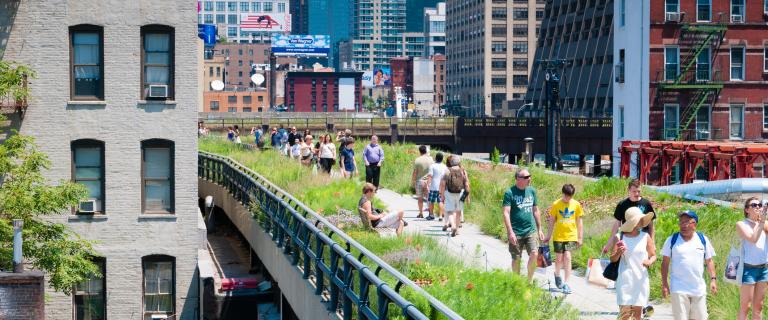

The most recent report from the UN Intergovernmental Panel on Climate Change released earlier this year issued a dire warning about the growing threats posed to people and ecosystems if urgent — if not immediate — action is not taken on climate change. But the report also outlined where mitigation — particularly in urban areas — could provide hope for meaningful climate action.
Two vice chairs and seven authors from the recent IPCC report came together at the annual Hixon Center Urban Conference , a gathering of researchers and practitioners focused on the potential impacts that cities have on climate change around the world, held on September 23 at the Yale School of the Environment. The conference is convened jointly by the Hixon Center for Urban Ecology and the Yale Planetary Solutions Project.
Topics of discussion included green infrastructure, public transportation, energy demand, and urban forests — “a climate mitigation buffet,” said Karen Seto, Frederick C. Hixon Professor of Geography and Urbanization Science at YSE and one of two coordinating authors of the urban mitigation chapter of the IPCC report.
“There are a variety of different options available [for mitigation]. There are enormous opportunities, but also challenges,” said Seto during the conference’s closing remarks.
One of the biggest challenges in climate action is urgency. To keep average global temperatures below the 1.5-degree Celsius target, global greenhouse gas emissions would need to peak by 2025 and be reduced significantly by 2030, said Ko Barrett, senior adviser for climate with the National Oceanic and Atmospheric Administration and an IPCC vice chair.
“Cities and urban areas are responsible for more than two-thirds of global greenhouse gas emissions, through the production and consumption of goods and services,” said Barrett. “About 70% of people worldwide will be living in cities by 2050, and 90 % in Africa and Asia in that same timeframe.
“More people, more emissions, right? Well, no. The concentrated nature of urban areas provides significant potential for emissions reductions” — from conserving urban forests to green design and retrofitting existing buildings to greater community engagement.
Changing how people live in cities will be paramount — particularly, lowering the demand for energy, said Diána Ürge-Vorsatz, director of the Center for Climate Change and Sustainable Energy Policy at Central European University and IPCC vice chair.
“By focusing on demand and services, there is potential to bring down global emissions by 40-70%,” said Ürge-Vorsatz. The biggest reduction could be found in retrofitting and repurposing existing buildings in place of building new structures to create “passive” buildings that require little to no energy-intensive heating or cooling. Passive homes also provide air quality benefits, and retrofitting existing buildings avoids repurposing new land for construction.
“Net-zero energy buildings are feasible in all climates and economical for almost all building types. The key to this is maximized energy efficiency and minimized energy and material demand,” said Ürge-Vorsatz.
Clara Pregitzer ’20 PhD, deputy director of conservation science at the New York City-based Natural Areas Conservancy and a contributing IPCC author, discussed how low-cost green and blue spaces in cities can help mitigate climate change impacts. These spaces can include protecting tidal marshes that absorb storm surge; planting new trees to reduce the urban heat island effect; and promoting healthy urban forests to enhance carbon sequestration.
“Often, urban forests are considered as tree canopy. [The Natural Areas Conservancy] focuses on forested natural areas, which may seem kind of niche,” said Pregitzer. “But it’s important to distinguish these types of forests for their care and management, but also for their different functions in carbon storage and sequestration.”
Full video of the conference available here.